Research on the Fault-Transient Characteristics of a DC Power System Considering the Cooperative Action of a Flexible Current-Limiting Device and a Circuit Breaker
Abstract
:1. Introduction
2. New Type of Flexible DC Current Limiting
2.1. Topology
2.2. Design of Application Layer Based on Hybrid Algorithm
2.3. Core Saturation Suppression
3. Synergistic Effect of Flexible Current Limiting and DC Circuit Breaker
3.1. Analysis on the Synergistic Process of Current-Limiting Inductor and DC Circuit Breaker
3.2. Analysis on the Synergistic Process of Flexible Current Limiting and DC Circuit Breaker
4. Simulation Analysis
4.1. Comparative Analysis of Current-Limiting Effect
4.2. Transient Analysis of Interpole Faults of Transmission Lines
- (1)
- Permanent failure
- (2)
- Instantaneous failure
5. Conclusions
- (1)
- By introducing reverse magnetic flux compensation of the controllable current source, the FCLD current-limiting reactance can obtain a stable clamping voltage. It can achieve obvious suppression on the fault current. It can eliminate the negative impact of the fault area on the non-fault area and ensure that distributed power sources in the network will not be disconnected due to voltage sags.
- (2)
- The cooperation of the FCLD and the DC circuit breaker can realize the circuit-breaker close without arc. The device can eliminate the negative impact of the fault on the non-fault area and realize the arc-free shutdown of the permanent-fault DC circuit breaker. Through the identification of permanent fault and transient fault, the circuit breaker action can be prevented when an instantaneous fault occurs. It can reduce the times of the circuit breaker action, the instantaneous-fault DC circuit breaker action probability, and the user power-loss rate.
- (3)
- According to the control scheme and the simulation results of the coordinated action of an FCLD and a DC circuit breaker, the FCLD proposed in this paper prolongs the protection action time of the circuit breaker and greatly reduces the interruption requirements of the DC circuit breaker. Furthermore, the validity of the proposed FCLD is verified, and a new protection idea is provided for the practical application of DC-system engineering.
- (4)
- The FCLDs can adjust the internal voltage of the system to maintain symmetrical operation of the system in the event of asymmetrical operation of the DC system.
Author Contributions
Funding
Data Availability Statement
Conflicts of Interest
Appendix A
| Converter Station 1 | Converter Station 2 | Converter Station 3 | |
|---|---|---|---|
| Rated Capacity of Converter Station (MV·A) | 20 | 10 | 10 |
| DC Voltage/kV | ±5 | ±5 | ±5 |
| DC Capacitance Value/mF | 4 | 2 | 2 |
| AC Reactance Value/mH | 50 | 70 | 70 |
| Smoothing Reactor/mH | 20 | 20 | 20 |
| R | Constant Voltage | P/Q | P/Q |
| Parameter | Value | Parameter | Value |
| R12/R13/R14/R23/R24/R34 | 0.08/0.08/0.08/0.08/0.08 | R1f/R2f | 0.02/0.08 |
| L12/L13/L14/L23/L24/L34 | 5 mH/5 mH/5 mH/5 mH/5 mH/5 mH | L1f/L2f | 1 mH/4 mH |
| Parameter | Value | Parameter | Value |
|---|---|---|---|
| ku_P | 1 | L1I | 0.1 mH |
| ku_I | 500 | L2I | 1 mH |
| R | 0.15 | n | 5 |
| L | 1.5 mH | k | 10 |
| Rc | 0.5 | C | 10 |
| a | 100 ms | tb | 100 ms |
| t* | 400 ms |
| Superconducting Current-Limiting Inductor | Flexible Current-Limiting Inductor | |
|---|---|---|
| Cost | USD 2,500,000 | USD 250,000 |
| Peak fault current | 350.6 A | 85.7 A |
| Time of the whole operation process | >200 ms | 35 ms |
| Device applications | Interpole faults | Interpole faults/pole to ground fault |
| Arc | Circuit breaker break-off with arc | Arc free |
References
- Zhang, Y.; Meng, X.; Shotorbani, A.M.; Wang, L. Minimization of AC-DC Grid Transmission Loss and DC Voltage Deviation Using Adaptive Droop Control and Improved AC-DC Power Flow Algorithm. IEEE Trans. Power Syst 2021, 36, 744–756. [Google Scholar] [CrossRef]
- Watson, J.D.; Lestas, I. Control of Interlinking Converters in Hybrid AC/DC Grids: Network Stability and Scalability. IEEE Trans. Power Syst 2021, 36, 769–780. [Google Scholar] [CrossRef]
- Pan, Y.; Chen, L.X.; Yuan, Z.; Xu, M.; Liu, L. Research on Current Limiting and Energy Limiting Technology for DC Power Grid Fault. Proc. CSEE 2020, 40, 2006–2015. [Google Scholar]
- Huang, H.; Xu, Z.; Lin, X. Improving Performance of Multi-Infeed HVDC Systems Using Grid Dynamic Segmentation Technique Based on Fault Current Limiters. IEEE Trans. Power Syst. 2012, 27, 1664–1672. [Google Scholar] [CrossRef]
- Zhu, S.; Zhao, C.; Li, C.; Xu, J. The DC Fault Current Calculation of DC Fault Current Limiter Action Included in Bipolar MMC-HVDC Grid. Proc. CSEE 2019, 39, 469–478. [Google Scholar]
- Wang, Y.; Yuan, Z.; Wen, W.; Ji, Y.; Fu, J.; Li, Y.; Zhao, Y. Generalized protection strategy for HB-MMC-MTDC systems with RL-FCL under DC faults. IET Gener. Transm. Distrib. 2018, 12, 1231–1239. [Google Scholar] [CrossRef]
- Xu, J.; Zhu, S.; Li, C.; Zhao, C. The Enhanced DC Fault Current Calculation Method of MMC-HVDC Grid with FCLs. IEEE J. Emerg. Sel. Top. Power Electron. 2019, 7, 1758–1767. [Google Scholar] [CrossRef]
- Gowaid, I.A. A Low-Loss Hybrid Bypass for DC Fault Protection of Modular Multilevel Converters. IEEE Trans. Power Deliv. 2017, 32, 599–608. [Google Scholar] [CrossRef] [Green Version]
- Lyu, H.; He, J.; Li, B.; Li, Y.; Spier, D.W.; Prieto-Araujo, E.; Gomis-Bellmunt, O. An Improved Hybrid DC Circuit Breaker with Self-Adaptive Fault Current Limiting Capability. IEEE Trans. Power Electron. 2022, 37, 4730–4741. [Google Scholar] [CrossRef]
- Sneath, J.; Rajapakse, A.D. Fault Detection and Interruption in an Earthed HVDC Grid Using ROCOV and Hybrid DC Breakers. IEEE Trans. Power Deliv. 2016, 31, 973–981. [Google Scholar] [CrossRef]
- Ma, D.; Chen, W.; Ye, H.; Xue, C.; Pan, P.; Zhu, X. An Assembly High Voltage DC Circuit Breaker Based on Pre-charged Capacitors 2018. In Proceedings of the IEEE International Power Electronics and Application Conference and Exposition (PEAC), Shenzhen, China, 4–7 November 2018. [Google Scholar]
- Ye, H.; Chen, W.; Pan, P.; Xue, C.; Azeem, S.W.; Zhu, X. A Novel Hybrid DC Circuit Breaker Based on Precharged Capacitors 2018. In Proceedings of the IEEE International Power Electronics and Application Conference and Exposition (PEAC), Shenzhen, China, 4–7 November 2018. [Google Scholar]
- Yang, S.; Xiang, W.; Lu, X.; Zuo, W.; Wen, J. An Adaptive Reclosing Strategy for MMC-HVDC Systems with Hybrid DC Circuit Breakers. IEEE Trans. Power Deliv. 2020, 35, 1111–1123. [Google Scholar] [CrossRef] [Green Version]
- Wei, X.; Zou, G.; Zhang, S.; Xu, C.; Sun, W. Adaptive Reclosing Scheme for flexible Multi-Terminal DC Distribution Grid 2021. In Proceedings of the 2021 6th Asia Conference on Power and Electrical Engineering (ACPEE), Chongqing, China, 8–11 April 2021; pp. 746–750. [Google Scholar]
- Mei, J.; Ge, R.; Zhu, P.; Fan, G.; Wang, B.; Yan, L. An Adaptive Reclosing Scheme for MMC-HVDC Systems Based on Pulse Injection from Parallel Energy Absorption Module. IEEE Trans. Power Deliv. 2021, 36, 1809–1818. [Google Scholar] [CrossRef]
- Zheng, T.; Lv, W.; Li, R. An Adaptive Reclosing Scheme Based on Phase Characteristics for MMC-HVDC Systems. IEEE Trans. Power Deliv. 2022, 37, 2986–2996. [Google Scholar] [CrossRef]
- Liu, J.; Tai, N.; Fan, C. A hybrid current-limiting circuit for DC line fault in multi-terminal VSC-HVDC system. IEEE Trans. Ind. Electron. 2017, 64, 5595–5607. [Google Scholar] [CrossRef]
- Zheng, F.; Zhang, J.; Lin, J.; Deng, C.; Huang, J. A Novel Flexible Fault Current Limiter for DC Distribution Applications. IEEE Trans. Smart Grid 2022, 13, 1049–1060. [Google Scholar] [CrossRef]
- Qiu, W.; Guo, M.; Zheng, Z.Y. Flexible Arc-suppression Method Based on Single-DC-source Cascaded H-bridge Converter for Earth Fault in Distribution Networks. Power Syst. Technol. 2019, 43, 3848–3858. [Google Scholar]
- Li, B.; Jing, F.; Jia, J.; Li, B. Research on Saturated Iron-Core Superconductive Fault Current Limiters Applied in VSC-HVDC Systems. IEEE Trans. Appl. Supercond 2016, 26, 5603805. [Google Scholar] [CrossRef]
- Li, B.; Jing, F.; Li, B.; Chen, X.; Jia, J. Study of the Application of Active Saturated Iron-Core Superconductive Fault Current Limiters in the VSC-HVDC System. IEEE Trans. Appl. Supercond. 2018, 28, 1–6. [Google Scholar] [CrossRef]
- Li, R.; Xu, L.; Holliday, D. Continuous operation of radial multiterminal HVDC systems under DC fault. IEEE Trans. Power Deliv. 2016, 31, 351–361. [Google Scholar] [CrossRef] [Green Version]
- Li, C.; Zhao, C.; Xu, J. A pole-to-pole short-circuit fault current calculation method for DC grids. IEEE Trans. Power Syst. 2017, 32, 4943–4953. [Google Scholar] [CrossRef]
- He, Z.; Wang, W.; Gu, H.; Li, G.; Xin, Y.; Wang, Z. Development Status and Prospect of Integrated Key Equipment of DC Power Grid with Fault Current Limiting and Breaking Functions. Proc. CSEE 2020, 646, 14–30. [Google Scholar]
- Liu, G.; Xu, F.; Xu, Z. Assembly HVDC breaker for HVDC grids with modular multilevel converters. IEEE Trans. Power Electron. 2017, 32, 931–941. [Google Scholar] [CrossRef]
- Qin, Y.; Wen, M.; Bai, Y. A Novel Distance Protection Scheme for HVDC Transmission Lines Based on Criterion Extremum Online Estimation. Proc. CSEE 2020, 647, 185–194. [Google Scholar]
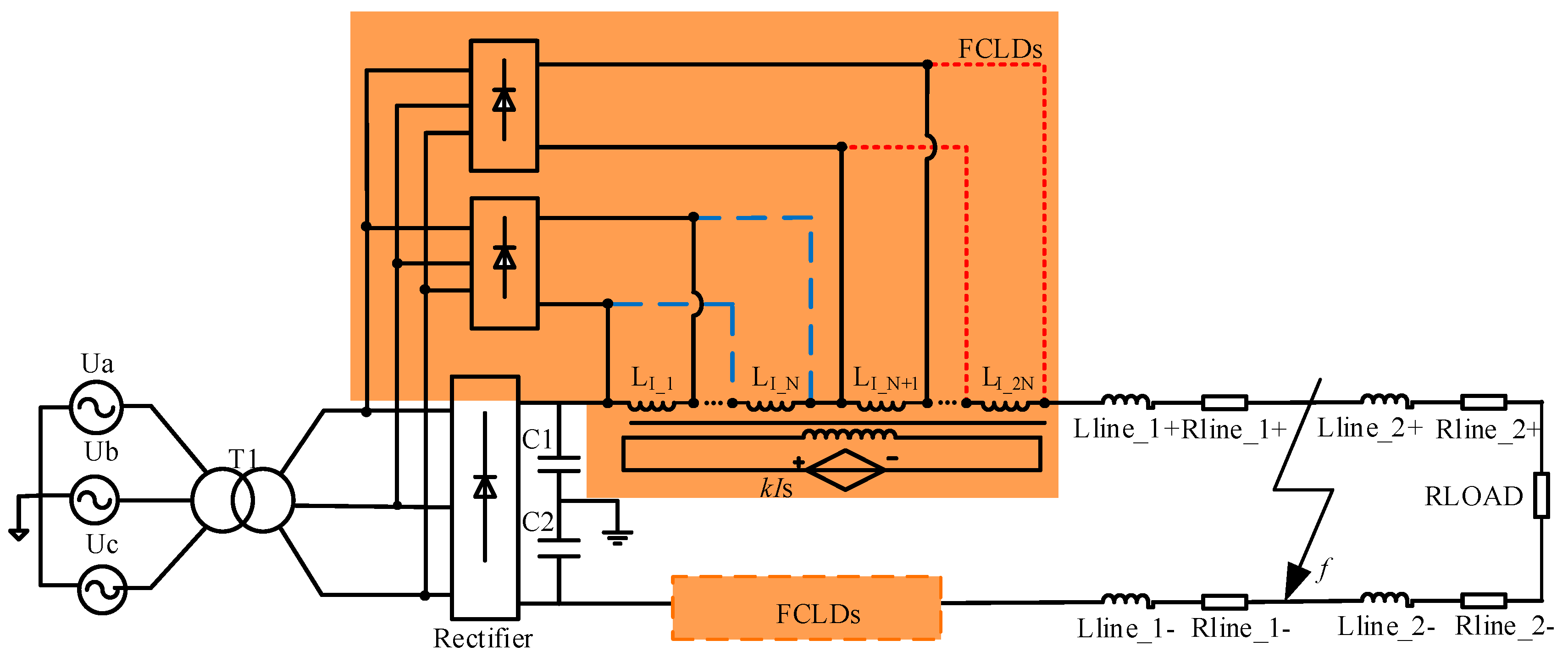

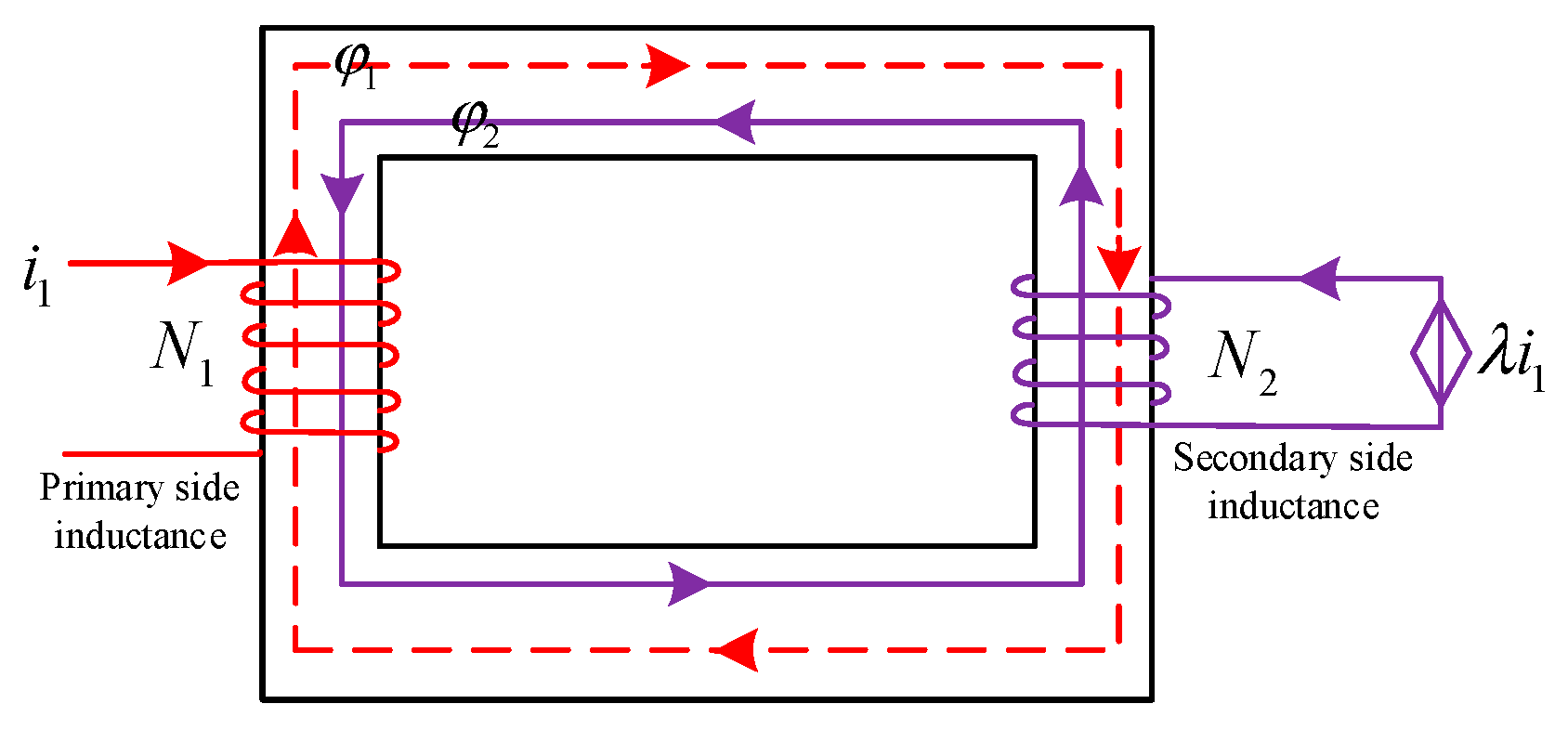
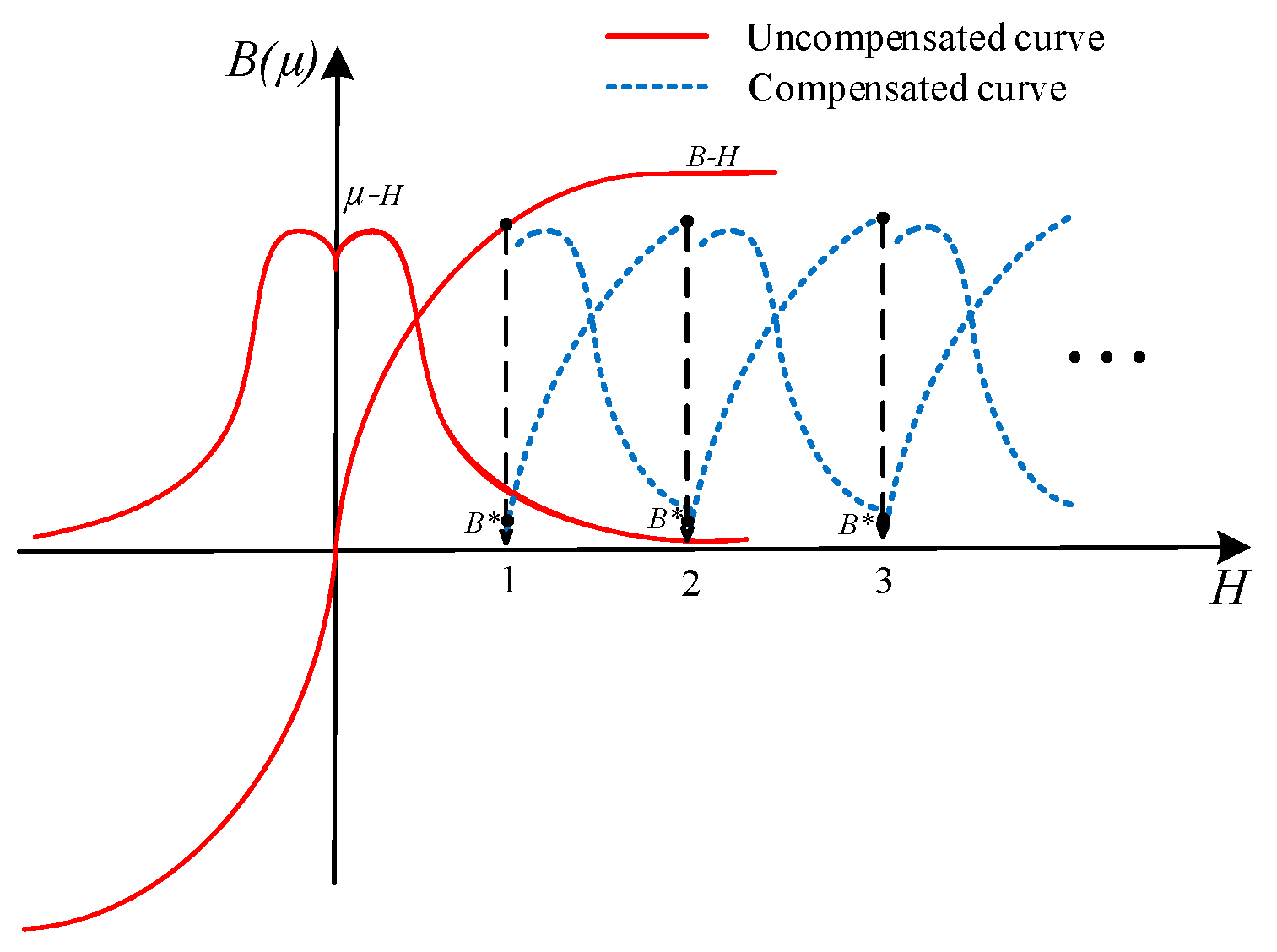




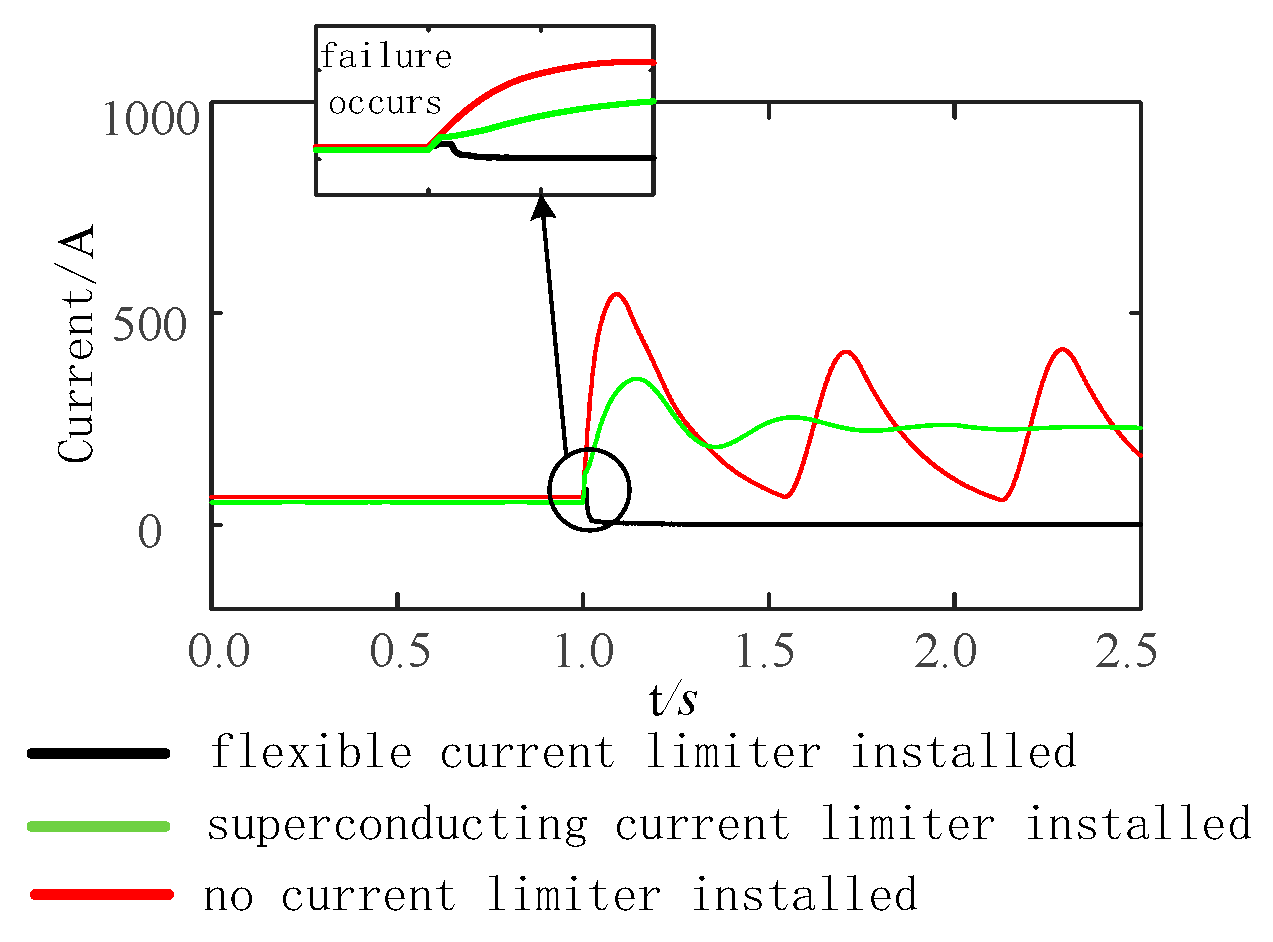

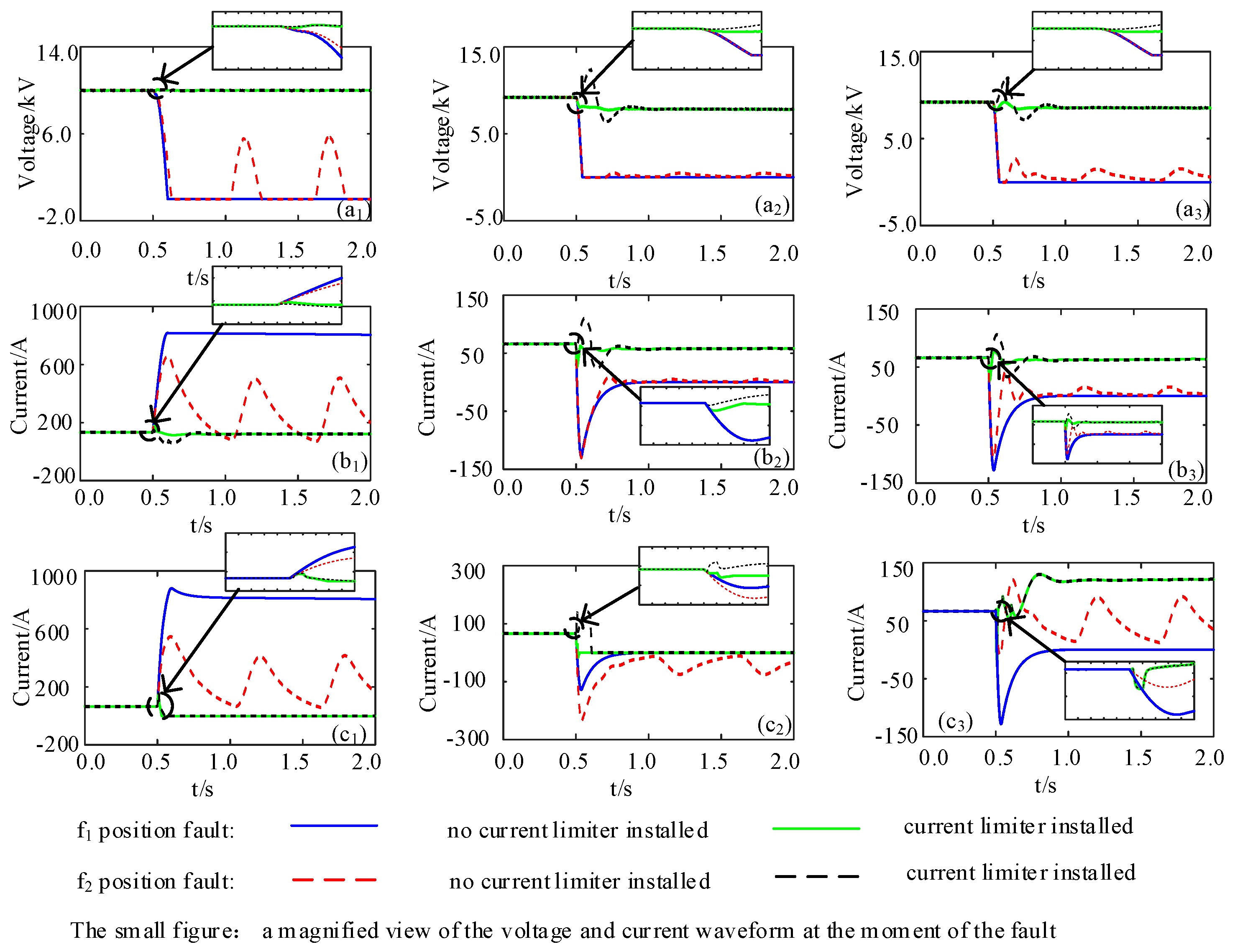
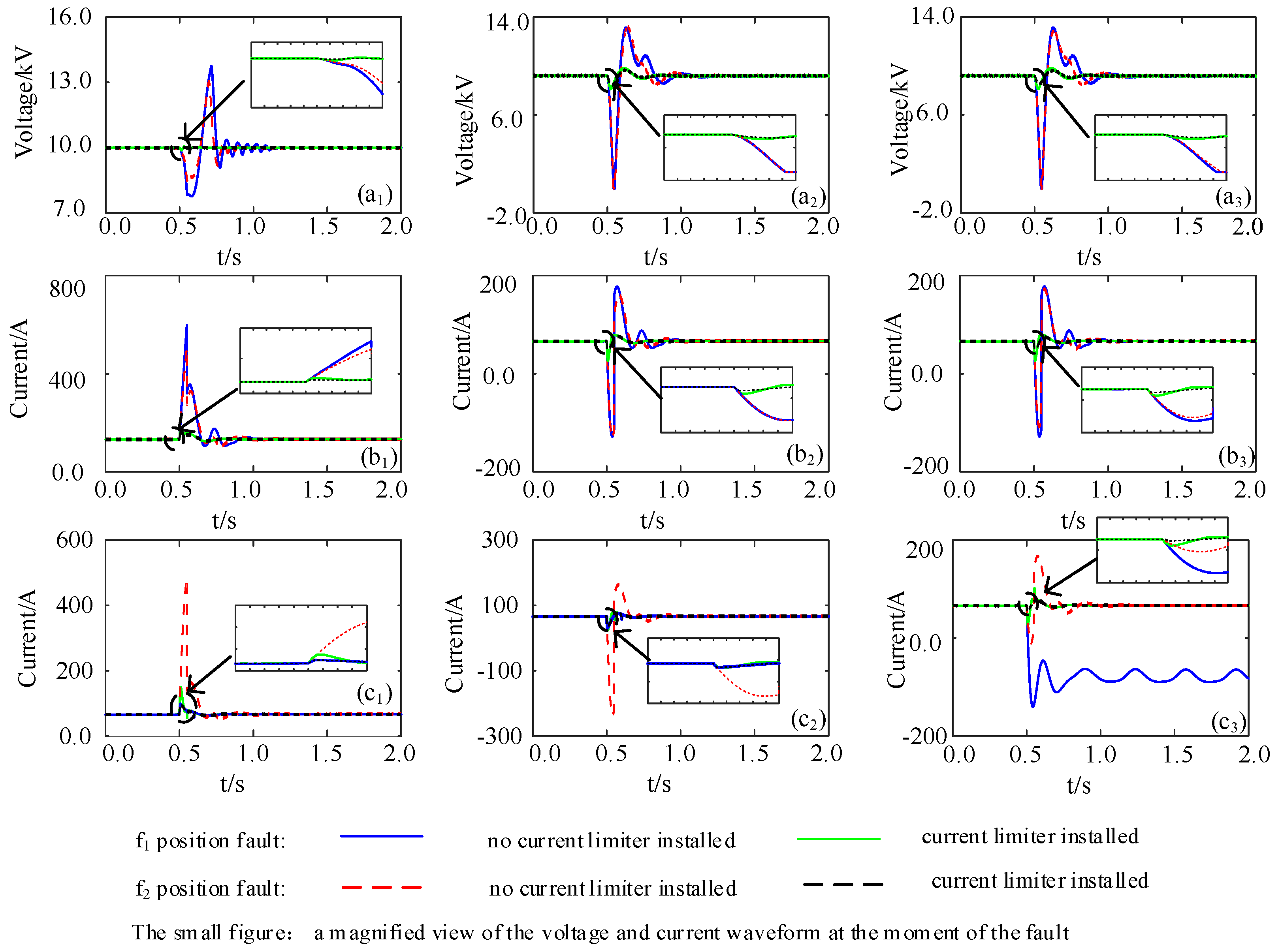
Disclaimer/Publisher’s Note: The statements, opinions and data contained in all publications are solely those of the individual author(s) and contributor(s) and not of MDPI and/or the editor(s). MDPI and/or the editor(s) disclaim responsibility for any injury to people or property resulting from any ideas, methods, instructions or products referred to in the content. |
© 2023 by the authors. Licensee MDPI, Basel, Switzerland. This article is an open access article distributed under the terms and conditions of the Creative Commons Attribution (CC BY) license (https://creativecommons.org/licenses/by/4.0/).
Share and Cite
Zheng, F.; Peng, Y.; Wang, W.; Zheng, S. Research on the Fault-Transient Characteristics of a DC Power System Considering the Cooperative Action of a Flexible Current-Limiting Device and a Circuit Breaker. Symmetry 2023, 15, 134. https://doi.org/10.3390/sym15010134
Zheng F, Peng Y, Wang W, Zheng S. Research on the Fault-Transient Characteristics of a DC Power System Considering the Cooperative Action of a Flexible Current-Limiting Device and a Circuit Breaker. Symmetry. 2023; 15(1):134. https://doi.org/10.3390/sym15010134
Chicago/Turabian StyleZheng, Feng, Yaling Peng, Weidong Wang, and Song Zheng. 2023. "Research on the Fault-Transient Characteristics of a DC Power System Considering the Cooperative Action of a Flexible Current-Limiting Device and a Circuit Breaker" Symmetry 15, no. 1: 134. https://doi.org/10.3390/sym15010134




